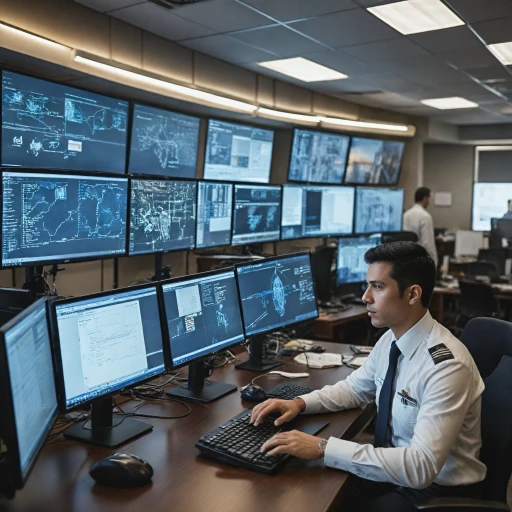
Understanding Operational Leadership in the C-Suite
The Essence of Leadership in Operational Management
For C-suite executives, understanding the intricacies of operational leadership is paramount. It's a crucial facet of effective management that intertwines seamlessly with strategic leadership. The role of operational leaders is more than just overseeing the daily operations; it involves aligning these operations with the broader organizational mission and strategic goals.
In essence, operational leadership encompasses various aspects including efficiency, clear communication, and decision-making agility. The success of organizational goals hinges on the ability of leaders to navigate business operations with clarity and foresight. As the frontline of implementing strategic initiatives, operational leaders foster environments conducive to achieving both short term and long term objectives.
Why Operational Leadership is Essential for Strategic Success
Strategic success is often conceived at the executive level but rarely sees fruition without robust operational management. Operational leaders serve as vital links that facilitate this transformation from strategy to execution. They ensure that team members are not working in silos but rather as an integrated unit focused on the company's strategic direction.
This form of leadership is particularly critical as organizations face increasingly complex environments where agility and continuous improvement are keys to maintaining a competitive edge. In these contexts, operational leaders must champion the adoption of effective business operations practices while fostering an organizational culture that incentivizes innovation and practical efficiency.
Challenges in Adopting Operational Leadership Approaches
Despite its critical role, operational leadership is not without challenges. The transition from strategy crafting in the C-suite to the nuts-and-bolts work of implementation is fraught with pitfalls. Executives must deftly bridge the gap between high-level directives and ground-level execution to prevent strategic plans from faltering before they achieve their goals.
Moreover, leaders must cultivate a keen understanding of both strategic and operational leadership to address emerging challenges swiftly and effectively. They must hone their skills continuously, sometimes through structured programs such as business school courses or online certificate offerings, to equip themselves for the dynamic demands of modern business landscapes.
For a deep dive into strategic and operational intricacies, you might find it helpful to explore how compliance challenges are navigated within organizational frameworks. Discover more about these compliance strategies for the C-suite.
Bridging the Gap Between Strategy and Execution
Aligning Strategic Intent with Operational Execution
In the realm of operational leadership, bridging the gap between strategic formulation and its execution is crucial for C-suite executives. This process requires more than just translating strategy into tasks; it demands a seamless alignment of strategic intent with operational actions. Successful leaders understand that the bridge requires both a robust strategy and an agile operational framework.
One of the primary goals for operational leaders is to translate high-level corporate strategy into action-oriented tasks that resonate with team members. This involves clear communication and a strong connection between strategic objectives and day-to-day operations. Such alignment ensures that the organizational goals are not only understood but also embraced across all levels of the organization.
Operational leaders must actively engage in strategic decisions and possess a deep understanding of the organization's business operations. This involves collaborating with strategic leaders to ensure operational tactics are aligned with long-term objectives. Effective operational leadership is characterized by a continuous improvement mindset, maintaining efficiency and adaptability to meet both short-term and long-term goals.
Fostering a Culture of Collaboration and Innovation
The success of bridging strategy and execution also depends on nurturing a culture of collaboration and innovation within the organization. Operational excellence is not just about day operations; it's about fostering an environment where team members feel empowered to contribute innovative solutions. Collaborative leadership paves the way for operations leaders to harness the collective expertise of their teams, driving effective operational practices.
By encouraging open communication and leveraging diverse perspectives, operational leaders can drive a culture that fuels progress and strategic alignment. Investing in leadership operational programs, such as business schools offering certificates in strategic and operational management, can equip leaders with the necessary skills to deftly navigate this complex landscape.
For insight into innovative approaches that facilitate successful strategy execution, consider exploring innovative approaches in the Felix Yip Strategy for C-Suite Success. By applying these techniques, C-suite executives can overcome the challenges of aligning strategy with operations, ensuring their organization achieves both operational efficiency and strategic growth.
Key Skills for Effective Operational Leadership
Crucial Abilities for Successful Operational Leadership
For C-suite executives aiming to excel in operational leadership, developing key skills is essential. It is the fine balance of strategic oversight and day-to-day management that defines effective operational leaders. These skills drive not only your organization’s success but also foster long-term operational excellence.
Clear Communication: At the heart of effective operational leadership is the ability to communicate organizational goals clearly. A strong operational leader ensures that each team member understands their role and how it connects with the broader strategy. Open lines of communication boost morale, facilitate swift decision making, and empower teams to execute with precision.
Continuous Improvement: Crafting a culture of continuous improvement is pivotal. Operational leaders must possess the capability to identify inefficiencies and implement improvements rapidly. This agile approach to business operations makes it possible to adapt quickly to market demands, leading to sustained strategic advantages.
Strategic and Operational Alignment: Bridging the gap between strategic vision and day-to-day execution is a core aspect of operations leadership. It involves aligning teams with strategic objectives and balancing short term achievements with long term aspirations.
Technology Integration: Embracing technology is no longer optional in modern management. It plays a crucial role in enhancing operational efficiency and productivity. Online platforms, data analytics, and management tools support operational leaders in making informed decisions that propel organizational growth.
For those at the helm of leadership, considering a leadership course can offer invaluable insights. Programs that focus on strategic leadership and operational excellence can further enhance a C-suite executive's capabilities, preparing them for the evolving business landscape.
The Role of Technology in Enhancing Operational Leadership
Harnessing Technology for Operational Excellence
In today's fast-paced business environment, technology plays a pivotal role in enhancing operational leadership. For C-suite executives, understanding and leveraging technology can bridge the gap between strategy and execution, leading to improved efficiency and organizational success.
Driving Efficiency with Advanced Tools
Operational leaders must embrace tools that streamline processes and foster clear communication within teams. From project management software that enhances day-to-day operations to data analytics platforms that provide insights into business operations, technology is indispensable for achieving long-term goals. By integrating these tools, leaders can ensure that their teams are aligned with the strategic vision of the organization.
Enhancing Decision Making with Data
Data-driven decision making is a cornerstone of effective operational leadership. By utilizing technology to gather and analyze data, leaders can make informed decisions that drive operational excellence. This approach not only supports short-term objectives but also aligns with the broader strategic goals of the organization. As a result, operations leaders can foster a culture of continuous improvement and innovation.
Training and Development for Technological Proficiency
For technology to truly enhance operational leadership, C-suite executives must prioritize training and development programs. These initiatives should focus on equipping team members with the necessary skills to utilize technology effectively. By investing in such programs, organizations can ensure that their leaders are well-prepared to navigate the complexities of modern business environments.
Balancing Technology with Human Insight
While technology is a powerful tool, it is crucial for operational leaders to balance it with human insight. Strategic leaders understand that technology should complement, not replace, the human element in decision making. By fostering a culture that values both technological proficiency and human expertise, organizations can achieve a harmonious balance that drives operational success.














